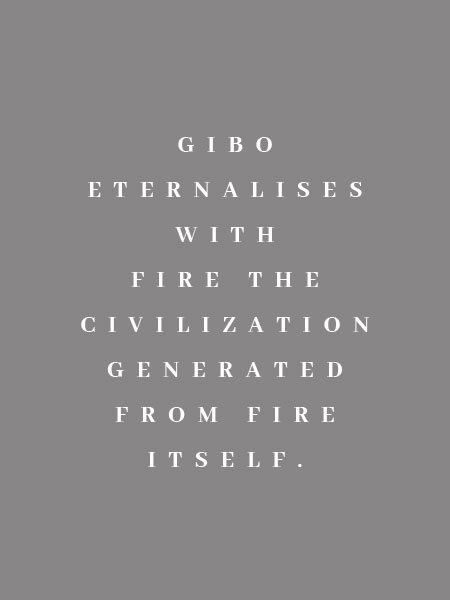
GIBO: HISTORY, ART AND THOUGHT
edited by Luigi Borgo
His history
Gilberto Angelo Perlotto, known as Gibo, is a descendant of an ancient Venetian family of iron masters. His forefather, Antonio Lora (1835 – 1922), was among the most active and recognized artists of his time in Europe. Gibo’s activity as an iron sculptor began in the early 1980s and continued uninterruptedly until today with a rich production of artistic works, shown in hundreds of exhibitions in Italy and abroad. He is one of the greatest contemporary exponents in ironwork art.
His art
From his first attempts, critics have ascribed Gibo’s work to the hyperrealist style. Hyperrealism was an artistic movement in vogue in the United States at the turn of the 60s and 70s, centred on the challenge between painting and photography in the objective representation of reality. The hyperrealistic artists wanted to show that the human eye can catch just the same details as the photographic lens; that man can equal the machine. Also in sculpture, hyperrealism has had a certain follow-up with the production of very accurate copies worthy of a “wax museum”. However Gibo’s hyperrealism is a different and new one: it does not arise from a photo projected on canvas so it can be painted, nor from a three-dimensional development of the photo into sculpture, the way the American hyperrealism of those years did. Moreover, Gibo does not use other materials than iron. In the hyperrealistic sculptures the silhouette was dressed with every-day clothes to complete it. Art resorted to non-artistic stratagems. This does not happen in Gibo. It is always the iron that becomes, to the human eye, matter other than itself. The art of Gibo is, thus, properly definable as “pure hyperrealism”: no model, a unique material. The sculpture emerges from a sketch on paper, from an idea, from an intuition of the artist who has the imaginative and constructive power to create a sculpture totally made in iron, so perfect as to be confused with the object as we know it in the reality, even if, in the reality there is not a real copy of it. The result is astonishing. It is unique, thanks to an iron processing technique that has no similar in the world. So, if the seventies hyper-realistic art had the aesthetic limit of being cold, conceptual and aseptic, an arid representation of the reality, all of Gibo’s art works and his “pure hyperrealism” contain, on the contrary, an extraordinary emotional load, a very powerful vitality deriving from this ability to think, observe the object with new eyes, to make it truer than truth, as well as from this sensitivity to feel, to own the iron and to mould it as if he were an authentic god of fire. For all these reasons Gibo’s works can lead the observer to a deep penetration and understanding of the human soul.
HisHis Thought
It was the coming of computer technologies and their applications that gave the hyperrealist art a new lease of life, just like it happened in the early 1970s, when the hyperrealist art was born as reaction to the spread of photography. Gibo was and still is the first and only sculptor of iron to produce pure hyper-realist art, where he recognizes, in the challenge between iron and pixel, the most penetrating and disruptive language to express his free, critical, artistic, salvific argument about the contemporary world. The topics he proposes are the Books, the Carèghe (the Chairs in Venetian Dialect), the Vegetable Garden, works on the Rural Memory, the painting Easels, the Metal-morphoses, the Cracks, all topics-objects produced by the homo faber, son of that civilization of fire from which we came and which we should never forget we belong to. Gibo says that in this ever-more computerized, seductive and engaging age of technology, we should stop belonging if we want to keep recognizing ourselves as men. Men as Prometeo, he intends, capable of challenging the supernatural, today represented by the “will of the web”, by the algorithms that think and choose for us. His issue is not anti-modern. Quite the contrary. Gibo does not evoke old topics-objects as a getaway from the contemporary world. He leads us into the future, in this increasingly virtual future, immortalising in the ever- mouldable iron, the beauty of a world of values, the earth, his idea of man, culture and art. In one definition, Gibo eternalises with fire the civilization generated from fire itself. So that future made of bits, bytes and web will surely see us all stronger men.